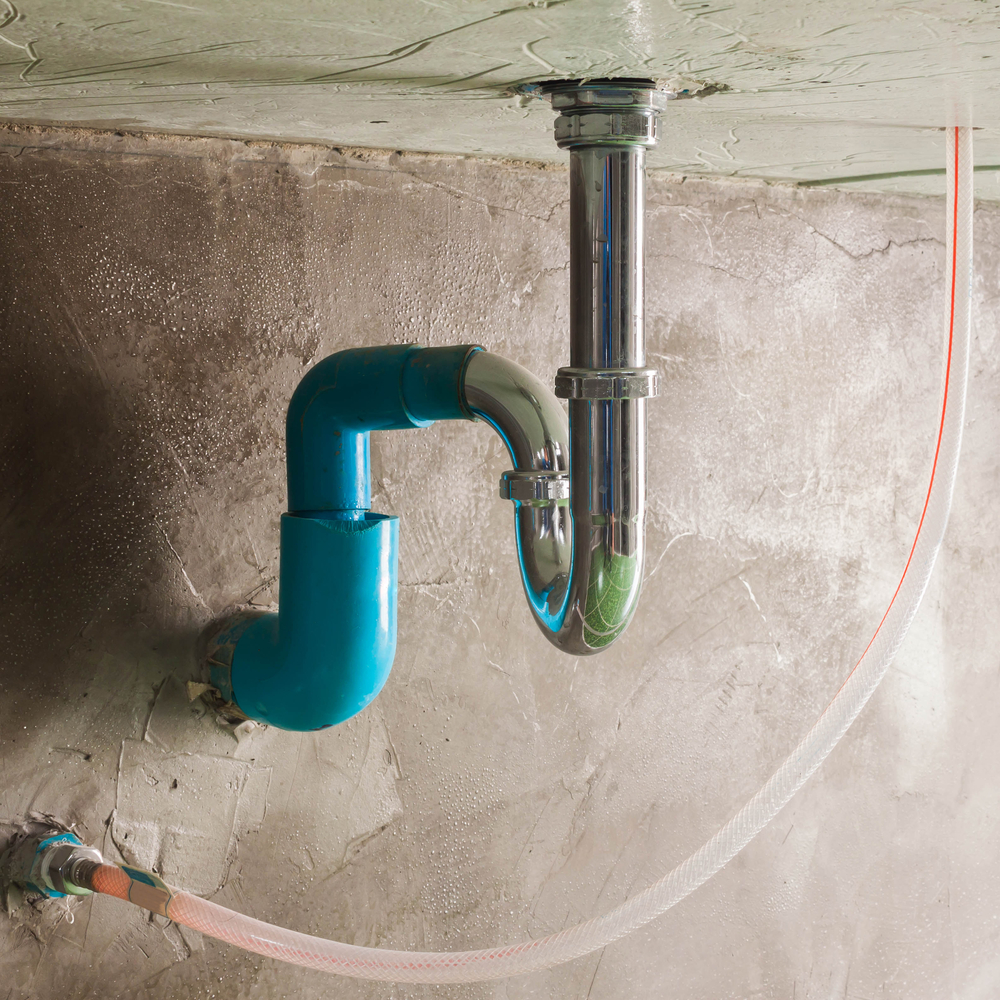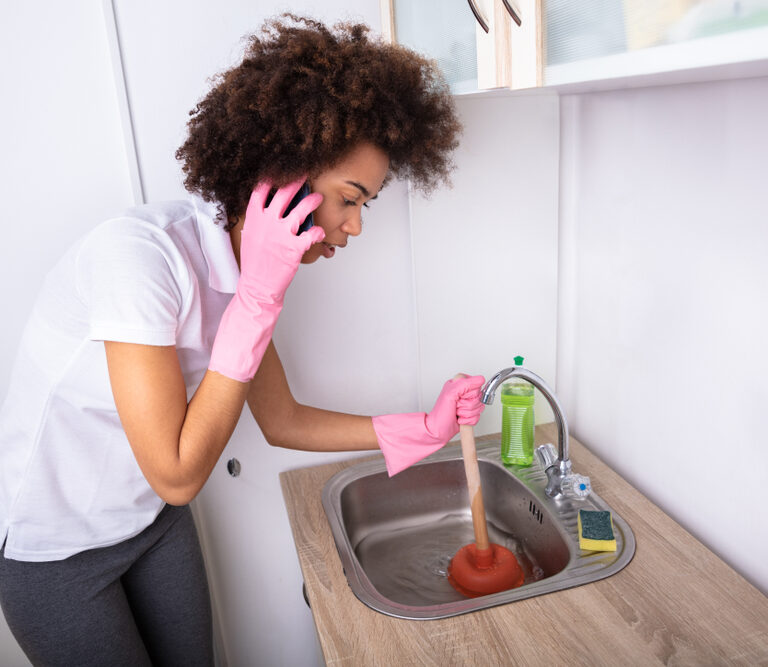If you’ve noticed that your bathroom sink is draining slowly, or not at all, then you’re dealing with a clog. Clogs are frustrating, but if you can clear them yourself, you’ll save quite a bit of money in the long run.
Flushing the Pipes
Sometimes the easiest approach to a problem is the most effective. Before you go busting out the tools, try giving your pipes a good flush.
Boiling Water
When it comes to bathroom sinks, the two most common things that cause clogs are soap scum and hair. As soap scum sticks to the walls of the pipes, hair can latch on, causing more surface area for future soap scum and hair to stick to.
A pot of boiling water works wonders at clearing these types of clogs. But before you break out the boiling water, make sure you know what kind of pipes your sink has. If you have PVC pipes, make sure to pull the pot of water from your stove before it reaches its boiling point, as you may risk melting your pipes.
If trying this method a couple of times doesn’t work, then you’ll need to try a different method to unclog your sink.
Baking Soda and Vinegar
The one-two punch of baking soda and vinegar is a great way to easily bust clogs. Even better, it’s gentle on your pipes and the environment, as well as your wallet. This makes the combination a great alternative to harsh chemical drain cleaners.
To start, make sure your sink doesn’t have any standing water in it. Then pour at least a cup of baking soda into the drain. Follow it up by slowly pouring a cup of vinegar into the pipe, and enjoy the fizzy show.
As the concoction fizzes, it may help loosen the clog enough to push it through your pipes. Make sure to let it sit for at least 30 minutes for minor clogs, or overnight for more stubborn clogs.
Finally, chase it with a large pot or bucket of hot water. If you’re successful, the water should jet down the pipes, leaving your sink working as good as new.
Fishing the Clog Out
If your sink is full of standing water, and you can’t flush them, then you might have to go fishing. Fishing a clog out of a bathroom sink isn’t very difficult, and depending on where the obstruction is, it might even be a quick job.
Drain Zipper
If you’ve got hair in your drain, the perfect way to remove it is with a drain zipper. Drain zippers are typically made of plastic, and are thin enough to reach into almost any drain without removing the drain cover.
The great part about drain zippers is that they’re disposable, so you won’t need to pick through the mess, though you can if you want to save the zipper for future clogs. Either way, prepare yourself for an unpleasant mess.
Wire Coat Hanger
If you’re in a pinch, and you’ve got a wire coat hanger lying around, then you can use it to help fish the clog out.
Start by straightening out the coat hanger, and then feed it down the drain. Adding a bit of a hook to the end of it will help grab the clog. Once you feel you’ve hooked the clog, pull it up and prepare yourself for a mess.
Plumbing Snake
If you’ve got a clog deep in your sink pipes, and a drain zipper or coat hanger can’t reach it, you may need to use a plumbing snake. Plumbing snakes have a fat coiled end that can help pull up the clog or bust it up enough for it to work through your pipes. For most bathroom sinks, you’ll need a 1/4-inch snake.
If you have a drain cover, you can try to maneuver the snake around the cover. However, you may have to remove it completely to get your snake into the pipe.
Once you have the snake in, you’ll want to slowly feed it through the pipe. Whenever you come to a point where the snake gets snagged on something, you’ll need to turn it with one hand as you push it through the pipe with the other.
If you can’t make it past the P-trap, you may have to take the P-trap off and go into the pipe directly. After you feel you’ve caught the clog with the snake, you’ll need to pull the snake out of the pipe.
If it comes back empty, feed the snake back into the pipe until you’ve reached the point where you originally felt the clog. Work the snake up and down, back and forth, to ensure the clog is properly broken up, and then try flushing with hot water.
Dislodging the Clog Out With Suction
If you don’t have the tools to fish the clog out of your sink drain, or can’t get past the drain stopper, you can try using suction to pull the clog free.
Plunger
Plungers are a plumber’s best friend, and for good reason. They can help pull clogs out of toilets, shower drains, and sink drains with little more than a firm grip and some push-pull action.
But while any plunger will technically work, you’ll specifically want a cup plunger, which is made for sink and shower drains. This will make it easier to form a good seal, and is much more sanitary than using the same plunger you use in your toilet (yuck).
You’ll want to make sure to have a little water in the sink to form a good seal. And if you’re still having a problem getting a seal to form, warm your plunger with hot water to make it more pliable, or use petroleum jelly around the lip to bridge any air gaps.
Once you have a seal, push down on the plunger to force the air out of it. At this point, you’ll want to firmly pull up and push down, focusing equally on both motions. This will create positive and negative pressure that can help work a clog out of your pipes.
After a few plunges, pull the plunger from the sink and see if it drains. If not, repeat as necessary, or move on to another method like snaking the drain.
Wet-Dry Vacuum
Perhaps the easiest and most effective, yet expensive option for pulling out a clog is to use a wet-dry vacuum, also known as a shop vac. These types of vacuums use a high-powered motor engineered to handle liquids and solids, and work great on clogs.
As with using a plunger, you’ll need to have a tight seal between the drain and the hose of the vacuum to pull the clog up. Since sink drains are usually small, this may not be difficult, but if you have trouble getting a seal to form, try using a towel or some petroleum jelly around the hose to fill the gaps. Also remember to cover the overflow pipe if your sink has one.
Apply pressure to the hose against the drain, and pulse the power on and off to help dislodge the clog. If you can’t get the clog from the drain at the bottom of the sink, you may need to attach the hose directly to the pipe, requiring you to disassemble the P-trap. Don’t worry, it’s not as scary as it sounds!

Manually Cleaning Your Pipes
While most clogs found in bathroom sinks consist of hair and soap scum, sometimes other things get lodged in your pipes. Furthermore, when using a plumbing snake or shop vac, you may find it necessary to disassemble the P-trap to reach the clog.
This can seem intimidating if you’ve never done this before. But rest assured – it’s actually quite simple, and may not even require tools.
Disassembling the P-Trap
Grab a bucket to catch any water still in the sink or P-trap, and inspect the trap to determine if you’ll need tools to remove it. With a sink that has PVC pipes, you may find you can turn the slip nuts by hand. You might also use gloves to help you get a firmer grip on the slip nut, or a wrench if the nut is too tight to turn.
For metal pipes, you can use a set of channel locks or a large adjustable wrench to loosen the nuts. You may also want to spray a bit of WD-40 if the pipes are corroded. Once you have the slip nuts loose enough to turn by hand, finish unscrewing them with your hand and pop a squat – you’re in for a ride.
From here, inspect the P-trap and check for any objects stuck in there. You’ll also want to check for clogs in both of the pipes the trap was connected to. If you’re disassembling the trap to hit the drains with a snake or vacuum, proceed as instructed above.
Once you’ve taken care of the clog, put the trap back on as you found it, and tighten the slip nuts. Run the sink, and make sure everything is flowing properly. And whatever you do, do not forget to make sure you properly tightened everything! You don’t want a leak that will eventually ruin your cupboard or floor.
Chemical Drain Cleaners
If all else fails, you can try a chemical drain cleaner. However, keep in mind that these are extremely toxic chemicals with the potential to harm you, and your plumbing.
Most drain cleaners are comparable, and work effectively for most common clogs, but some are more harmful for your pipes than others.
If you want a drain cleaner that won’t harm you or your pipes, opt for an enzyme-based cleaner. Enzyme cleaners use microorganisms to eat through the organic components of a clog, so they’ll take a lot more time than something like Drano. They’re better for slow drains and routine maintenance to prevent future clogs. But given enough time, they can bust through even tough clogs.
WARNING!
If you’ve recently put any chemicals in your drain, including baking soda and vinegar, you should thoroughly rinse your sink and flush your drain with water before using a chemical drain cleaner. Certain combinations of chemicals can create extremely noxious gases that can put you and your family in harm’s way.
Maintain Your Drain
Once you’ve freed the clog and your sink is draining properly again, use this experience as a lesson to maintain your drains. Remember those enzyme cleaners we mentioned? They work wonders at preventing your drains from becoming clogged.
For sinks with open drains, drain strainers are also a great way to prevent clogs. These will help prevent hair and other objects from going down the drain, meaning fewer future clogs.
Clear Your Pipes, Not Your Wallet
Nobody gives their plumbing a second thought until it starts having issues. Thankfully, resolving common issues like clogs is relatively easy and affordable. With a bit of persistence and the right tools, you can have your sink draining like new without draining your wallet.
